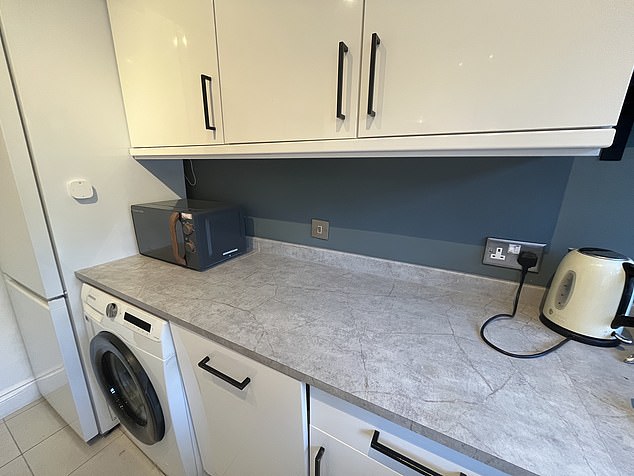I recently moved to a new house. The kitchen countertops are quartz, essentially faux marble, which is not to my taste.
But more worryingly, quartz has now been reported to cause health problems in kitchen installers who have handled it.
Redoing the kitchen is not a priority, so I was planning on replacing the countertops in a couple of years.
But given these concerns, should you consider doing it sooner? I’ve seen people calling for the material to be banned, which has already happened in Australia.
Would it be difficult to find a dealer willing to pick it up? I imagine it would be difficult to get rid of.
Concerned: A reader wants to know if it is safe to remove the quartz countertop in the kitchen, as shown in the photo.
This is Money’s Jane Denton responds: Quartz is an artificial stone, also known as reconstituted or reconstituted stone.
Quartz kitchen countertops have become popular over the past two decades due to their durability and appearance.
They are typically made of 90 percent ground quartz and 10 percent resins and pigments.
While being processed into its final countertop shape, the stone has been reported to release harmful particles of fine silica dust into the air.
Once inhaled into the lungs, the particles can accumulate and cause internal scarring and inflammation of the lungs, known as silicosis.
In July 2024, Australia banned the use, supply and manufacture of artificial stone.
According to reports, since 2010 cases of silicosis from artificial stones have been reported in different parts of the world. Cases have now also been identified in Britain.
A report published in the medical journal Thorax in August 2024 called Artificial stone silicosis: a case series in the United KingdomHe said: “Cases are likely to increase in the UK, so urgent action is needed to identify them and enforce regulations.”
I have asked a medical expert and a trades expert for their opinion on your question.

Fix Radio host Clive Holland says quartz countertops can be removed safely with the right equipment
Fix Radio host and home improvement expert Clive Holland says: Quartz countertops can be dangerous to workers due to their high levels of crystalline silica, which can cause silicosis, a fatal and incurable lung disease.
However, once installed, these surfaces pose no threat unless affected by new cutting, drilling or similar activities.
A trained professional can safely remove a quartz countertop if proper precautions and protective equipment are taken.
Alternatively, the countertop can be left in place and covered with marble or granite coverings.
Granite countertops, in particular, are a great choice for kitchens and bathrooms.
They are durable, resistant to damage and spills, and easy to maintain. This method ensures that the quartz countertop remains sealed underneath, eliminating any potential risk of silica exposure.
This approach not only improves the appearance of the space, but also provides a practical and safe solution.
By opting for overlays, homeowners can enjoy the benefits of a durable, stylish surface without the dangers associated with annoying quartz.
It is a smart and effective option both in security and functionality.

Lung disease expert Dr. Johanna Feary says removing a quartz countertop will release very little dust.
Dr Johanna Feary, consultant in occupational lung diseases at the Royal Brompton Hospital, says: Quartz countertops are known by many different names, but basically they are all forms of artificial or artificial stone made from crushed rocks mixed with resins and pigments to provide the desired finish. They are very practical, resistant and attractive materials.
However, a key feature is that they can contain very high levels, more than 90 percent, of silica compared to, for example, marble, which contains almost no silica. This means that when quartz countertops are cut or polished, the dust produced contains very high levels of silica.
If sufficient precautions are not taken to protect workers from this dust, they will breathe large amounts of silica dust. If someone repeatedly breathes in silica dust, it can cause silicosis.
It is an incurable and often progressive disease that causes hardening of the lungs.
At first it causes no symptoms, so people don’t realize there may be a problem.
If it progresses, symptoms of shortness of breath, cough and tiredness may appear. The first thing people often comment on is that they feel more short of breath than before when doing things like climbing stairs, taking a brisk walk, or playing soccer with their children. Over time, this can progress to the point that they become short of breath when walking slowly or showering.
In silicosis, due to these countertops, those affected are an unusually young group of people with an average age of only 34 years.
It appears they all worked for companies where precautions to protect workers from dust were inadequate. Sadly, the first death occurred in the United Kingdom this year: that of a man who was only 28 years old.
The risk is only for the merchants who cut and polish the stone and almost all of this is done in the workshops.
Once the countertops are installed there is no risk for the owner. Disposing of it will release very little dust, so it should be easy if you decide to replace it.


